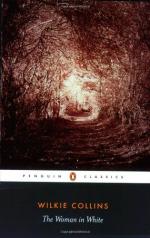“Devilish true, and very well put,” cried a voice at the entrance of the boat-house. Sir Percival had recovered his equanimity, and had come back while we were listening to the Count.
“Some of it may be true,” I said, “and all of it may be very well put. But I don’t see why Count Fosco should celebrate the victory of the criminal over Society with so much exultation, or why you, Sir Percival, should applaud him so loudly for doing it.”
“Do you hear that, Fosco?” asked Sir Percival. “Take my advice, and make your peace with your audience. Tell them virtue’s a fine thing—they like that, I can promise you.”
The Count laughed inwardly and silently, and two of the white mice in his waistcoat, alarmed by the internal convulsion going on beneath them, darted out in a violent hurry, and scrambled into their cage again.
“The ladies, my good Percival, shall tell me about virtue,” he said. “They are better authorities than I am, for they know what virtue is, and I don’t.”
“You hear him?” said Sir Percival. “Isn’t it awful?”
“It is true,” said the Count quietly. “I am a citizen of the world, and I have met, in my time, with so many different sorts of virtue, that I am puzzled, in my old age, to say which is the right sort and which is the wrong. Here, in England, there is one virtue. And there, in China, there is another virtue. And John Englishman says my virtue is the genuine virtue. And John Chinaman says my virtue is the genuine virtue. And I say Yes to one, or No to the other, and am just as much bewildered about it in the case of John with the top-boots as I am in the case of John with the pigtail. Ah, nice little Mousey! come, kiss me. What is your own private notion of a virtuous man, my pret-pret-pretty? A man who keeps you warm, and gives you plenty to eat. And a good notion, too, for it is intelligible, at the least.”
“Stay a minute, Count,” I interposed. “Accepting your illustration, surely we have one unquestionable virtue in England which is wanting in China. The Chinese authorities kill thousands of innocent people on the most frivolous pretexts. We in England are free from all guilt of that kind—we commit no such dreadful crime—we abhor reckless bloodshed with all our hearts.”




